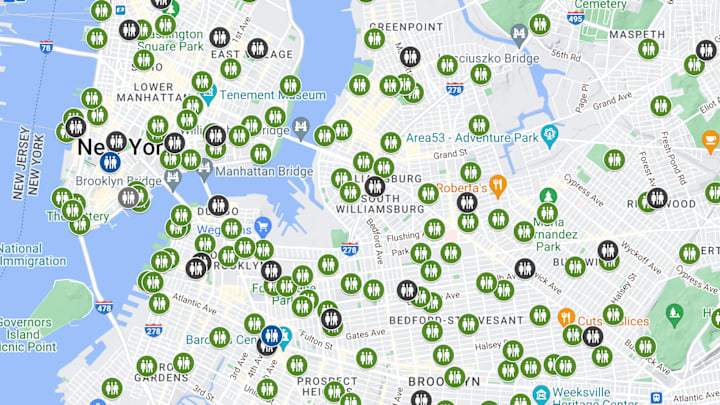When you gotta go, you gotta go. But go where?
Earlier this month, New York City Mayor Eric Adams announced the release of a new Google Maps layer to show city public restrooms and promised to build or renovate 82 facilities. The initiative’s name? “Ur in Luck.”
“Everyone—seniors, parents with kids, anyone enjoying the day outdoors, needs access to a public bathroom without having to buy anything or beg for a code,” Deputy Mayor for Operations Meera Joshi said in a statement.
Aside from the traditional uses, people need restrooms for a lot of reasons, like taking medications, changing diapers, menstrual management, or breastfeeding. Public restrooms promote walking, public transit, community, and public health [PDF]. Easy access is especially important for the wellbeing of women, people experiencing homelessness, the elderly, people with disabilities, and people with certain illnesses. In Toilet: Public Restrooms and the Politics of Sharing, sociologist Laura Norén notes that thousands of New Yorkers who make the city what it is rely on public facilities: people like taxi drivers, street vendors, bike messengers, and newsstand operators.
Tackling a Shitty Problem

Yet, many American cities have a dismal record of providing relief. A 2024 study ranked public park restroom access for 98 cities. New York City ranks 86, with 11,553 residents per single restroom. Fort Worth, Texas, was last on the list, with only one restroom for every 59,963 residents. St. Petersburg, Florida, is at the top with a facility for every 1554 residents.
Public restrooms are expensive to maintain and can be targets of vandalism. They can also be a center of controversy. “For more than 100 years,” author Neil J. Young writes in Politico, “Americans have projected their most profound fears about social change onto public restrooms.” Victorians freaked out about women working and peeing outside of the home. In the 1950s, white people were scared of racial desegregation in bathrooms. In 2016, there was a rash of state anti-trans “bathroom bills.” Now, there are fears around unhoused people and drug use in public toilets.
Even though New York City’s new program won’t solve many issues, it does help with access. The new map categorizes restrooms by location such as park, library, or transit station and lists information like gender divisions, accessibility, and whether there is a changing table. Most facilities are in parks, with library locations second.
“Part of making New York City a more livable city is tackling the little things—the things we don’t think about until we need them,” Mayor Adams said. “Access to public restrooms is high on that list, maybe even number one or two.”
Read More Stories About Toilets:
